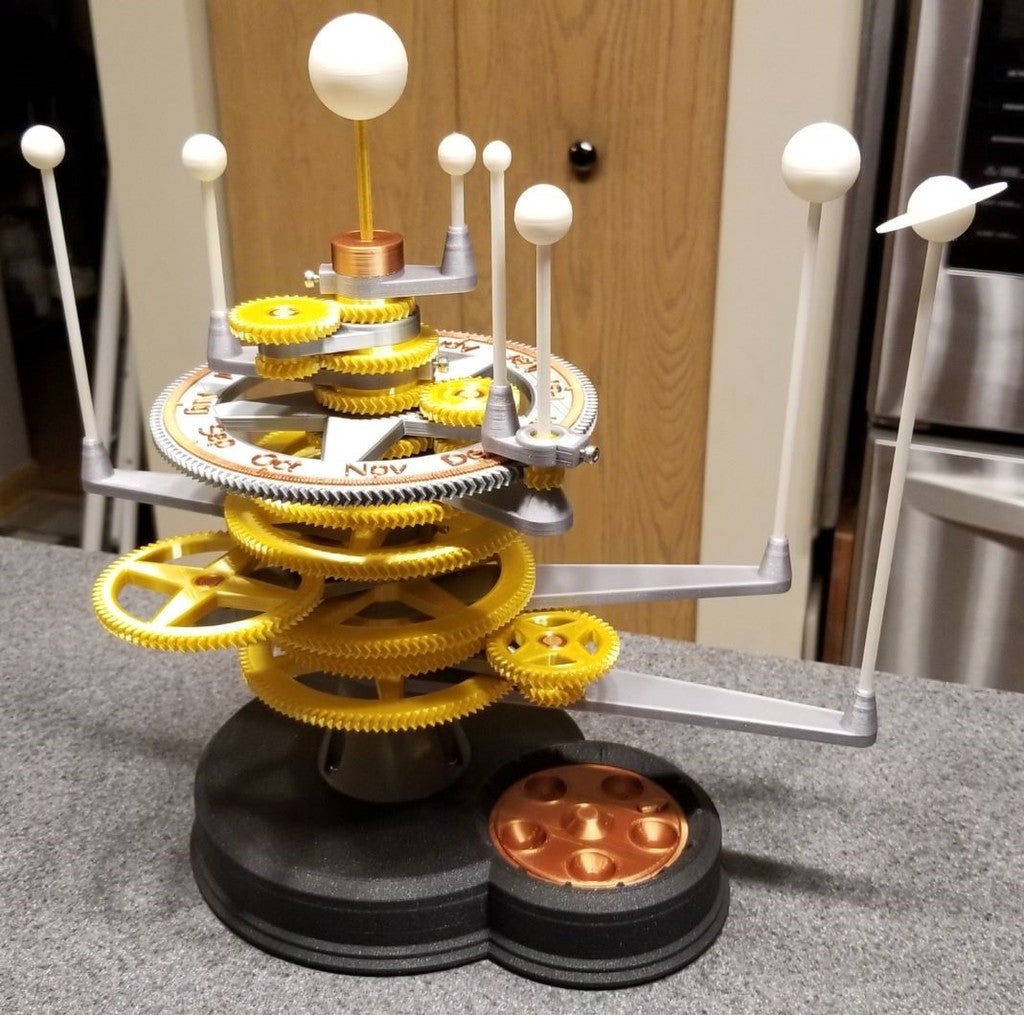
Mechanical Planetarium - Tuned
prusaprinters
<p>This is an optimized version of the "Mechanical Planetarium" model by Zippitybamba. His original model is on Thingiverse here: <a href="https://www.thingiverse.com/thing:4613061">https://www.thingiverse.com/thing:4613061</a></p> <p>I printed a few parts of the original model on my Prusa I3 MK3S, and I wasn't satisfied with how they fit. This sent me down a rabbit hole of refactoring and tuning the file until I could print it with insanely low tolerances of about 0.12mm on average.</p> <p>The original model is truly excellent and deserves to be on the main page for a long time. I put in a lot of time tuning this, so I thought I should share what I've done.</p> <p>A quick summary of edits:</p> <ul> <li>Combined the base and upper mechanism into one file.</li> <li>Added toggles for rendering each object.</li> <li>Refactored source for ease of reading and editing.</li> <li>Switched to the English fork of "Getriebe.scad" named "Gears.scad". Translated by Chris Spencer. <a href="https://github.com/chrisspen/gears">https://github.com/chrisspen/gears</a></li> <li><p>Added several customizer sliders to:</p> <ul> <li>Compensate for printer Z thickness.</li> <li>Control spacing for meshing of the gears in the base.</li> <li>SCALING! The model is scalable between 50-150% on the X and Y axes only. Object Z heights are controlled separately. Tolerances are corrected so they don't change as you adjust the overall scale. (Scaling to 90% will make it fit on a Prusa Mini)</li> </ul> </li> <li><p>Adjusted the length of the Venus planet arm (by 1mm) so the peg doesn't collide with the idler wheel above it.</p> </li> <li>Tightened everything up so it could be printed on a well calibrated machine with very minimal post-processing. I only needed to smooth out bits on the top layer due to filament retraction.</li> </ul> <p>I also wrote a quick Windows Batch file to generate all 47 files. A word of warning; It will absolutely hammer your processor since it opens a separate copy of OpenSCAD in the background for each file. If you know your way around OpenSCAD, then I'm assuming that you know how to read and use a batch file. "Here be dragons."</p> <p>Update: I identified a small issue with the inner pegs on the Calendar Gear. They were protruding 0.1mm above the center bearing. This would not be an issue for 99% of people printing the model, but I fixed the file and posted an update. If you're printing at anything larger than 100% or a layer height below 0.2mm, take a look at your preview.</p> <p>Update 2: I fixed an issue with non-uniform scaling of the printable planets in the SCAD file.</p> <h3> All credit for this design belongs to Zippitybamba. All I did was clean things up and tweak a bunch of things.</h3> <h3>Print instructions</h3><h3>Print Settings</h3> <p><strong>Printer Brand:</strong> Prusa<br/> <strong>Printer:</strong> I3 MK3S<br/> <strong>Rafts:</strong> No<br/> <strong>Supports:</strong> No<br/> <strong>Resolution:</strong> 0.4mm Nozzle. Layer Varies: 0.2mm and 0.25mm<br/> <strong>Infill:</strong> 15% Grid<br/> <strong>Filament:</strong> Prusament, Mika3D, and Sain Smart PLA</p> <p><strong>Notes:</strong></p> <p>I generally used three perimeters for all objects with the exception of the Mercury Axle. I used five perimeters for that so it would print essentially solid with no fast infill moves. I split the Mercury Axle in half and printed it vertically one piece at a time. I joined the halves using a small piece of aluminum rod that I wedged into the hole in the middle.</p> <p>I also tweaked my perimeter extrusion widths extensively so it would always print full perimeters. In PrusaSlicer it's on the "Advanced" tab under "Print Settings". I adjusted the "Perimeters" and "External Perimeters" while checking the preview until the white "Gap Fill" was replaced with a yellow perimeter.</p> <p>Watch out for Elephant's Foot. If you're using PrusaSlicer, go back into your Advanced Print Settings and adjust the "Elephant foot compensation" until you have a crisp bottom edge.</p> <p>If you use Cura, or some other slicer, poke around in your settings and look for similar options.</p>
With this file you will be able to print Mechanical Planetarium - Tuned with your 3D printer. Click on the button and save the file on your computer to work, edit or customize your design. You can also find more 3D designs for printers on Mechanical Planetarium - Tuned.
